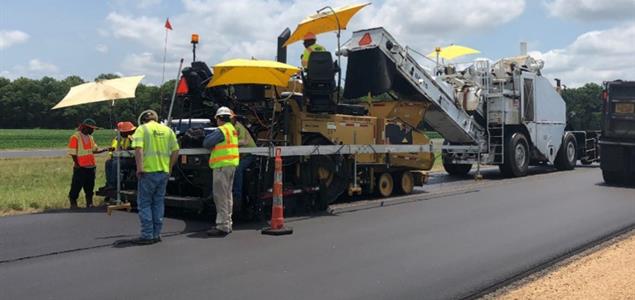
Pennsylvania's State Transportation Innovations Council (STIC) remains focused on moving innovations forward that increase the efficiency and resiliency of Pennsylvania's vast transportation system. Coupled with the goal of finding innovative ways to minimize the transportation industry's carbon footprint and decrease greenhouse gas (GHG) emissions, the STIC's Construction and Materials Technical Advisory Group (TAG) recently introduced Cold Central Plant Recycle (CCPR) of Asphalt Flexible Pavements, which aims to do just that.
When it comes to asphalt pavements, there are two easy and effective ways to reduce carbon emissions. One is to increase the use of Reclaimed Asphalt Pavement (RAP) by putting more RAP into the asphalt mix; the second is to reduce the temperatures that are used to produce it.
CCPR of Asphalt Flexible Pavements does both. It uses 100% RAP, a material generated when asphalt pavements are removed for reconstruction, rehabilitation, or resurfacing and deemed of beneficial use by the Department of Environmental Protection, to create a new flexible asphalt base that provides almost the same structural capacity as a hot mix asphalt base while reducing carbon emissions. Additionally, as the name suggests, the material is mixed cold, meaning no heat is added during the process.
"CCPR is great for pavements that are in fair condition, being the pavement structure has moderate to severe distresses, but is not quite at the end of life, and the underlying materials are considered to still be in good condition," said Dr. Mary Robbins, technical director for the Pennsylvania Asphalt Pavement Association. "It is not meant to be a final wearing surface, so while it might be open to traffic during construction, it should be topped with an asphalt overlay or surface treatment."
CCPR takes RAP that is either milled from the project site and/or RAP that has been stockpiled previously, and it is mixed at the plant with a liquid, such as asphalt emulsion or foamed asphalt, and a small amount of cement, to create the new flexible asphalt base. It addresses some of the deeper distresses on roadways by focusing on the underlying materials, provides a longer life span than the typical mill and fill and is more cost-effective.
To show that it is a cost-effective and sustainable solution for future use, the Construction and Materials TAG is looking to pilot CCPR on higher volume roads in PennDOT districts where most of the RAP is currently stockpiled. Projects using CCPR in Virginia on Interstates 64 and 81 saw significant costs savings and sections of those Interstates completed in a much shorter timeframe.
The current PennDOT specification for CCPR limits its use to lower volume routes, with less than 15,000 vehicles per day. However, the largest quantities of RAP in Pennsylvania are stockpiled in the urban areas, such as PennDOT's District 6, in the Philadelphia region, and PennDOT's District 8 in the Harrisburg region. By piloting this innovation on higher volume roads, the Construction and Materials TAG is hoping to expand its use in the future.
ABOUT THIS BLOG
Did you know PennDOT is directly responsible for nearly 40,000 miles of highway and roughly 25,000 bridges? We oversee programs and policies affecting highways, urban and rural public transportation, airports, railroads, ports and waterways, in addition to administering the state's more than 11 million vehicle registrations and 8.8 million driver's licenses.
So, how do we do what we do? And how can we help you travel in Pennsylvania — whether it be for business or leisure — in safe and enjoyable manner? Read PennDOT Way to learn more about the department, what we do, and how and why we do it.
TAGS
50-Year Anniversary, 511PA, Aggressive Driving, Airports, Autonomous Vehicles, Bicycles, Bridges, Child Safety, Community Relations, Construction, COVID-19, Distracted Driving, District 1, District 10, District 11, District 12, District 2, District 3, District 4, District 5, District 6, District 8, District 9, DOTcom, Driver and Vehicle Services, Emergency Responders, Employment, Equity, FAQ Friday, Human Trafficking, Impaired Driving, Innovations, Live Free Ride Alive, Maintenance Monday, Motorcycles, Older Drivers, PA Motorcycle Safety Program, Pedestrians, PennDOT Connects, Ports, Public Transit, Railroads, REAL ID, Road MaP, Roadside Beautification, Rural Roads, Safety, School Buses, Seat Belts, State Transportation Innovation Council (STIC), Sustainability, Teen Drivers, Throwback Thursday, Transportation Funding, Travel in PA, Welcome Centers, Winter, Work Smart, Work Zone, Yellow Dot
LATEST POSTS
PennDOT Continues Sharing, Updating Resources for Local Governments to Pursue Bipartisan Infrastructure Law Funding Opportunities
Norwin High School Wins 2024 ‘Innovations Challenge’
Demo Complete: I-95 CAP Project in Center City Philadelphia
PennDOT Archeologist Connects Past, Present, and Future
Lehigh Valley DUI, Highway Safety Task Force Hosts Law Enforcement Seminar
ARCHIVES
2024
2023
2022
2021
2020
2019
2018
2017

